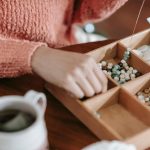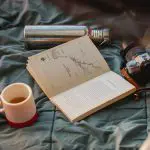If you're aiming for that perfect tea-stained look, it's crucial to start with the right materials and a well-prepared tea solution. You'll want to choose quality paper that holds the stain well and brew your tea just right for optimal color. Different application techniques can yield surprising results, so experimenting is key. But how do you control the intensity of the stain without losing that appealing depth? Let's explore some effective strategies that can elevate your tea-staining projects to the next level.
Table of Contents
Key Takeaways
- Use high-quality paper like watercolor or cardstock for a durable tea-stained effect, and choose natural tea bags without additives for best results.
- Brew strong black tea and steep for 15 to 20 minutes for optimal color depth; longer steeping yields darker stains.
- Experiment with various application techniques such as spraying, brushing, or dipping to achieve the desired texture and pattern.
- Air dry stained items in a well-ventilated area, avoiding heat sources to preserve the stain's appearance and integrity.
Choosing the Right Materials
To create the perfect tea-stained look, you'll need high-quality materials like sturdy paper and natural tea bags for the best results.
Start by selecting paper that can handle the staining process without tearing or warping. Watercolor paper or cardstock works well, as they're designed for various mediums.
Next, opt for natural tea bags without artificial additives. Black tea is a popular choice due to its rich color, but you can experiment with green or herbal teas for different shades. Just ensure they're free from any synthetic ingredients that might affect your desired outcome.
You'll also want to gather a few tools for application. A paintbrush, sponge, or spray bottle can help you control the staining process. If you're looking for a more intricate design, consider using stencils or stamps alongside your tea solution.
Preparing Your Tea Solution
Start by brewing a strong tea solution to achieve the ideal staining effect. Choose black tea for a rich, dark color; it works best for creating that vintage look. Begin by boiling about four cups of water, then add six to eight tea bags or three to four tablespoons of loose tea. Let it steep for at least 15 to 20 minutes. The longer you steep, the deeper the color will be, so don't hesitate to experiment.
Once your tea has reached the desired strength, remove the tea bags or strain out the loose leaves. Allow the solution to cool slightly, as this will make it easier to work with. If you want to enhance the staining effect, consider adding a tablespoon of vinegar to the solution; this can help set the stain and create a more permanent finish.
After preparing your tea solution, you'll be ready to move on to the staining process. Remember, the key to achieving that perfect tea-stained look lies in the strength of your solution, so don't rush this step. A well-prepared tea solution will set the foundation for a beautifully aged appearance.
Techniques for Staining
With your tea solution prepared, it's time to explore different techniques for applying the stain effectively.
One popular method is the spray technique. Fill a spray bottle with your tea solution, and lightly mist your fabric or paper. This approach provides a more uneven, organic look, which is perfect for achieving that authentic vintage feel.
If you prefer more control, try using a brush or sponge. Dip your brush or sponge into the tea solution and apply it in even strokes. This method allows you to cover larger areas quickly and ensures a consistent application.
For a more textured appearance, consider the scrunch technique. Take a piece of fabric or paper, scrunch it up, then dip it into the tea solution. Let it sit for a moment before unfolding it. This method creates beautiful, random patterns that mimic the look of naturally aged items.
Lastly, you can use a dipping technique. Submerge your material in the tea solution for a few seconds, then remove it and let it dry. This method gives a more uniform stain, perfect for projects that require a cohesive look.
Experiment with these techniques to find the one that suits your project best!
Controlling the Color Intensity
Adjusting the strength of your tea solution lets you control the color intensity and achieve the desired vintage effect on your fabric or paper.
To start, choose the type of tea you want to use. Black teas tend to create darker, richer tones, while herbal teas offer lighter or more muted shades.
Once you've selected your tea, steep it for varying lengths of time. A longer steeping time results in a more concentrated solution, leading to deeper colors. If you want a lighter stain, steep the tea for just a few minutes and then dilute it with water.
When you're ready to stain, dip a small piece of fabric or paper into the solution to test the color. This test helps you gauge how the final product will look.
If it's too light, steep the tea longer or use less water. If it's too dark, add more water and mix well until you reach the desired shade.
Drying and Setting the Stain
Once you've achieved your desired color intensity, the next step is to properly dry and set the stain to ensure it lasts. Proper drying is crucial; if you don't let the piece dry correctly, the stain might smudge or fade over time.
Here are some tips to help you through the drying and setting process:
- Air Dry: Place your stained item in a well-ventilated area. Avoid direct sunlight, as it can alter the color.
- Use a Fan: If it's a humid day, a fan can speed up the drying process without causing damage.
- Avoid Heat: Don't use a hairdryer or heat gun, as excessive heat can affect the stain's appearance.
- Check for Tackiness: Before handling, ensure the stain feels dry to the touch. If it's tacky, give it more time.
Layering for Depth
To achieve a rich, tea-stained look, you'll want to layer your colors effectively.
Choosing complementary shades can enhance the overall depth, while varying your staining techniques adds texture and interest.
This approach not only brings your project to life but also creates a unique, handcrafted appearance.
Choose Complementary Colors
How can you effectively choose complementary colors to enhance the depth of your tea-stained creations? Selecting the right colors can elevate your projects, making them visually appealing and rich in texture. Here are some tips to guide you:
Earthy Tones: Opt for deep browns, burnt oranges, and muted greens to complement your tea stains.
Soft Pastels: Light blues, pinks, and yellows can create a lovely contrast without overpowering the tea's natural hues.
Metallic Accents: Gold or copper can add a touch of elegance, enhancing the rustic feel of your stained pieces.
Neutral Shades: Whites, creams, and grays can soften the overall look, providing a balanced backdrop for your tea stains.
Layering Colors: Don't hesitate to layer colors. This technique can create a stunning visual depth, especially when paired with your tea-stained background.
Vary Staining Techniques
Incorporating different staining techniques can significantly enhance the depth and richness of your tea-stained projects, allowing you to create more intricate and visually captivating designs. By varying your approach, you'll achieve a stunning layered effect that draws the eye.
Start by applying a base layer of tea, letting it dry completely. Next, experiment with additional layers using different tea strengths or types for contrast. You might use a lighter brew for subtle highlights and a stronger brew for deeper shadows.
Here's a quick reference table to help you choose your techniques:
| Technique | Description |
|---|---|
| Base Staining | Apply a uniform layer of tea for a foundation. |
| Gradient Staining | Blend lighter and darker shades to create a gradient. |
| Spot Staining | Use a small brush to add concentrated spots of color. |
Mixing these techniques allows for greater creativity, so don't hesitate to play around! The more you layer, the more dynamic your project will become, making it a true work of art. Enjoy the process, and let your imagination guide you!
Caring for Tea-Stained Items
Caring for your tea-stained items is crucial to maintain their unique charm.
You'll want to use gentle cleaning techniques, store them properly, and know the right restoration methods to keep them looking great.
Let's explore these essential tips to ensure your tea-stained pieces stay beautiful for years to come.
Gentle Cleaning Techniques
To preserve the beauty of your tea-stained items, use gentle cleaning techniques that won't damage their fabric or finish. Here are some effective methods to keep your treasures looking their best:
- Spot Clean: Use a soft cloth to dab at stains, rather than rubbing, to prevent fabric damage.
- Mild Detergent: Mix a few drops of a gentle detergent with water. Test on a small area first before applying it to the entire item.
- Cold Water Rinse: Always rinse your items with cold water after cleaning to remove any soap residue and prevent further staining.
- Air Dry: Let your items air dry naturally. Avoid direct sunlight, as it can fade the colors and weaken the fabric.
Storage Recommendations
Proper storage is essential for maintaining the charm of your tea-stained items and preventing unwanted damage over time.
To start, always keep your tea-stained fabrics in a cool, dry place. Avoid direct sunlight, as UV rays can fade the beautiful hues you've achieved. You might consider using acid-free tissue paper to wrap delicate items. This helps prevent creases and keeps the fabric from sticking together.
For wooden pieces, apply a thin layer of beeswax or mineral oil to protect the surface. Store these items upright to avoid pressure that could lead to warping.
If you're keeping tea-stained paper or photographs, consider using archival-quality boxes to shield them from dust and moisture.
Humidity can be a real enemy, so use silica gel packets in storage containers to absorb excess moisture.
Regularly check on your items to ensure they're safe and sound. If you notice any signs of damage, address them promptly to avoid further deterioration.
Restoration Methods
Restoring your tea-stained items requires a gentle approach to maintain their unique charm while addressing any wear or fading. You want to ensure that your cherished pieces are preserved without losing their character. Here are some effective restoration methods to consider:
Gentle Cleaning:
Use a soft cloth and mild soap to clean the surface. Avoid harsh chemicals that could damage the finish.
Reapply Tea Stain:
If the color fades, you can lightly reapply a diluted tea mixture to achieve a consistent look. Test on a small area first.
Condition Wood:
For wooden items, use a natural wood conditioner to nourish the grain and enhance the color.
Repair Scratches:
Fill any scratches with a matching wood filler or wax crayon, then buff to blend it in with the surrounding area.
Store Properly:
Keep your restored items in a cool, dry place, away from direct sunlight to prevent further fading.
Frequently Asked Questions
Can I Use Herbal Tea for Staining Fabrics?
Yes, you can use herbal tea for staining fabrics! It offers a unique color and scent. Just brew the tea strong, let it cool, and soak your fabric until you achieve the desired shade.
How Long Does the Tea Stain Last on Items?
Tea stains can last for a while, but their longevity depends on fabric type and care. Generally, you can expect them to remain intact unless washed vigorously or treated with strong detergents.
Is It Safe to Tea-Stain Children's Clothing?
Yes, it's generally safe to tea-stain children's clothing. Just ensure you use natural tea without additives. Always test a small area first to avoid any potential allergic reactions or unexpected results on the fabric.
Can I Mix Different Tea Types for Unique Colors?
Yes, you can mix different tea types to create unique colors! Experiment with combinations like black, green, and herbal teas. Just remember to test your mixture on a small fabric piece before committing to a full project.
What Surfaces Are Best for Tea Staining?
When tea staining, you'll find that absorbent surfaces like cotton, linen, and paper work best. These materials soak up the color beautifully, giving you rich, varied tones that enhance your creative projects.
- Why Open-Weave Scrim Is the Secret to Stunning Event and Canopy Designs - June 26, 2025
- Creating Large-Scale Art Installations With Scrim Fabric - June 26, 2025
- Scrim Fabric in Upholstery: Understanding Its Use as a Backing Material - June 26, 2025






